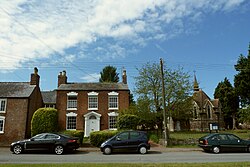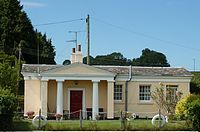Purton, Berkeley: Difference between revisions
Created page with "{{Infobox town |name=Purton |county=Gloucestershire |picture=Purton, houses and church.jpg |picture caption= |os grid ref=SO691042 |latitude=51.7361111 |longitude=-2.4480556 |..." |
|||
| (One intermediate revision by the same user not shown) | |||
| Line 25: | Line 25: | ||
==River crossing== | ==River crossing== | ||
[[File:Canal house, Purton.jpg|right|thumb|200px|Canal bridgekeeper's house]] | |||
[[File:Berkeley Arms, Purton - geograph.org.uk - 1708664.jpg|right|thumb|200px|The Berkeley Arms]] | |||
There was a ferry across the river to the other Purton by 1282. In the late 18th and early 19th century, there was also a ford across the river here. The ferry, known as Purton Passage, continued in use until 1879, when it was replaced by the [[Severn Railway Bridge]].<ref>{{VCH|5|Lydney|pp=46-84}}</ref> | There was a ferry across the river to the other Purton by 1282. In the late 18th and early 19th century, there was also a ford across the river here. The ferry, known as Purton Passage, continued in use until 1879, when it was replaced by the [[Severn Railway Bridge]].<ref>{{VCH|5|Lydney|pp=46-84}}</ref> | ||
Latest revision as of 14:05, 21 February 2020
| Purton | |
| Gloucestershire | |
|---|---|

| |
| Location | |
| Grid reference: | SO691042 |
| Location: | 51°44’10"N, 2°26’53"W |
| Data | |
| Postcode: | GL13 |
| Local Government | |
| Council: | Stroud |
Purton is a village on the east bank of the River Severn in Gloucestershire, three miles north of Berkeley. It stands opposite the hamlet of Purton (near Lydney) on the west bank of the river.
The Gloucester and Sharpness Canal reaches the Severn here, but turns and runs beside the riverbank to join it only at Sharpness a mile to the south-west.
The name of the place derives from the Old English pirige tun, meaning "pear orchard".[1]
Parish church
The parish church is St John The Evangelist, built in 1874.[2]
River crossing


There was a ferry across the river to the other Purton by 1282. In the late 18th and early 19th century, there was also a ford across the river here. The ferry, known as Purton Passage, continued in use until 1879, when it was replaced by the Severn Railway Bridge.[3]
The Berkeley Arms public house is on the Campaign for Real Ale's National Inventory of Historic Pub Interiors.[4]
Tidal erosion barrier
In the early 20th century, a number of old vessels were run aground along the bank of the Severn, near Purton, to create a makeshift tidal erosion barrier to reinforce the narrow strip of land between the river and canal.[5][6] barges, trows and schooners were 'hulked' at high tide, and have since filled with silt. More boats have been added, including the schooner Katherine Ellen which was impounded in 1921 for running guns to the Irish Republican Army, the Kennet and Avon Canal barge Harriett, and Ferrous Concrete Barges built in the Second World War.[7]
Purton Passage SSSI
Purton Passage (SO687045) is a 12-acre geological Site of Special Scientific Interest near Purton.[8] It is adjacent to the Severn Estuary SSSI.
Rocks of the Upper Ludlow Silurian age are exposed on the foreshore at Tites Point. These include bone beds, and the area is a declared important educational resource for the study of vertebrate palaeontology. Most important are the plates of Cyathaspis banksi. The remains of primitive fish include thelodont denticles and acanthodian fragments.
Inspections by Natural England in 2009 report only acceptable change due to the natural processes of estuarine muds, and no establishment of vegetation; this is controlled due to the natural process of tidal scour.[9]
Purton Water Treatment Works
Built in the 1970s, the treatment works filters water from the Gloucester and Sharpness Canal and the River Frome and supplies around half of Bristol’s water supply.
Site of Berkeley Castle's old duck decoy pond
This is the site of the old decoy pond; the new one is due north east at Slimbridge Wildfowl and Wetlands Centre, and is maintained in full working order.
In 1886 Sir Ralph Payne Gallwey's 'The Book of Duck Decoys' records:[10]
"...3 miles N. of the town of Berkeley, 12 miles SW. of Gloucester, and close to the south bank of the River Severn, within a mile E. of Purton. These are the only Decoys in the county. The pools, of which there are two within a mile of one another, are about an acre apiece in extent, and there are four pipes to each. The old pool is on the verge of the S. bank of the Berkeley and Gloucester Canal, which was formed so close to it that, fearing the Decoy would suffer therefrom, the new Decoy was constructed in 1840 between the canal and the Severn, on the New Grounds."
Outside links
| ("Wikimedia Commons" has material about Purton, Berkeley) |
References
- ↑ Mills, Anthony David: 'A Dictionary of British Place-Names' (Oxford University Press, 2003) ISBN 978-0-19-852758-9
- ↑ Churches Database: St John, Purton
- ↑ A History of the County of Gloucester - Volume 5 pp 46-84: Lydney (Victoria County History)
- ↑ Brandwood, Geoff (2013). Britain's best real heritage pubs. St. Albans: CAMRA. p. 44. ISBN 9781852493042.
- ↑ "The Purton Hulks". morturn.com - Legacy from the past. http://www.morturn.com/locations/Sites/Purton/Purton_Site_Page.htm. Retrieved 2008-10-19.
- ↑ "Purton Barge Graveyard". Gloucester Docks and Sharpness Canal website. http://www.gloucesterdocks.me.uk/canal/graveyard.htm. Retrieved 2009-09-06.
- ↑ "Purton Hulks - maritime history sunk by neglect". telegraph.co.uk (London). 2008-10-18. https://www.telegraph.co.uk/earth/main.jhtml?xml=/earth/2008/10/18/eaboatwreck118.xml. Retrieved 2008-10-19.
- ↑ SSSI listing and designation for Purton Passage
- ↑ Natural England SSSI information on the Purton Passage unit of assessment
- ↑ Gallwey, Sir Ralph Payne: 'The Book of Duck Decoys' (1886) Chapter 7, p 93
